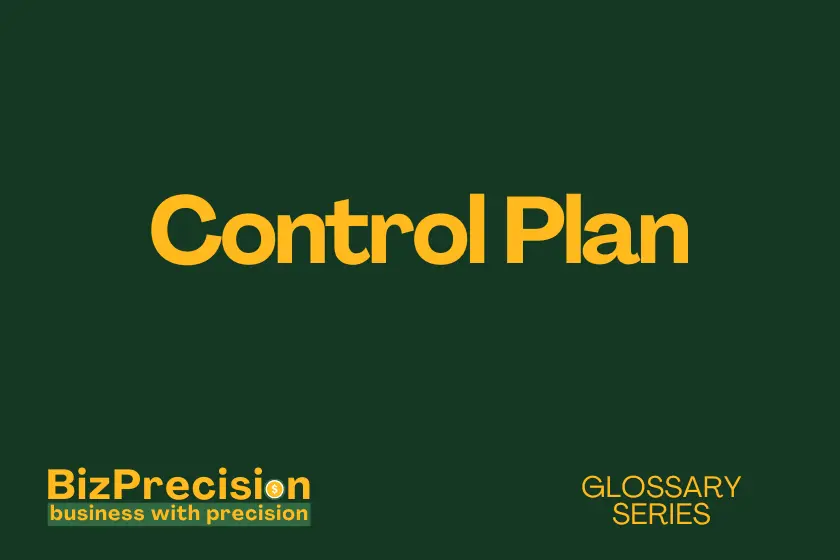What is a Control Plan?
A control plan is a documented system that outlines specific quality control measures for manufacturing processes.
Manufacturing quality issues cost companies an average of $29 million annually, according to a 2023 Quality Management Report by the American Society for Quality (ASQ). Control plans help prevent these costly problems.
You’re about to discover how control plans can transform your quality management process. Let’s explore why they’re essential for modern manufacturing success.
Understanding Control Plans in Quality Management
Core Components of a Control Plan
A control plan starts with clear process specifications. These tell you exactly what to measure. Your specifications need regular updates to stay current.
Key elements of every control plan include:
Process Steps: List each production step in order. Each step needs clear documentation to prevent confusion. Workers can then follow the sequence without mistakes.
Control Methods: Define how you’ll check quality at each step. Your methods should match the specific needs of each process. Regular testing ensures these methods work well.
Measurement Tools: Specify which tools to use for quality checks. Each tool needs proper calibration for accurate results. Train workers to use these tools correctly.
Action Limits: Set clear boundaries for acceptable quality. When results fall outside these limits, take action fast. Quick responses prevent major quality issues.
Types of Control Plans
Prototype Control Plans help with new product development. These plans test initial designs before full production. They catch problems early when fixes cost less.
Pre-Launch Control Plans guide pilot production runs. They help fine-tune processes before mass production. Your team can spot potential issues early.
Production Control Plans manage ongoing manufacturing. They ensure consistent quality during regular production. Regular updates keep these plans effective.
Control Plan Implementation Process
Start with a clear timeline for implementation. Build support among team members first. Success depends on everyone understanding their role.
Training comes next. Workers need to know their quality control tasks. Regular practice sessions build confidence and skill.
Monitor results closely at first. Make adjustments based on early feedback. Your plan should improve over time.
Benefits and Applications of Control Plans
Quality Assurance Benefits
Control plans reduce defect rates by 67% on average. They help catch problems before they affect customers. Your reputation stays strong.
They create consistent quality standards. Workers know exactly what to check. This prevents confusion and mistakes.
Regular monitoring prevents major issues. Small problems don’t become big ones. Your products maintain high quality.
Cost Reduction Impact
Quality problems cost less when caught early. Studies show early detection saves 80% in repair costs. Your bottom line improves significantly.
Control plans cut waste in production. They help optimize material usage. You save money on raw materials.
Training costs drop over time. Workers make fewer mistakes. Your efficiency increases steadily.
Risk Management Advantages
Control plans help prevent recalls. They catch problems before products ship. Your brand stays protected.
Documentation proves quality compliance. Auditors see your quality commitment. You meet industry standards easily.
Early warning systems prevent crises. You spot trends before they become problems. Your business stays stable.
Production Efficiency Improvements
Workers waste less time on rework. They get things right the first time. Your productivity goes up naturally.
Standardized processes speed up production. Everyone follows the same steps. Your output becomes more predictable.
Quality checks become routine habits. Workers know what to look for. Your efficiency keeps improving.
Creating and Maintaining Effective Control Plans
Step-by-Step Development Guide
Start with process mapping. Document each step in your production line. This creates your plan’s foundation.
Identify critical control points. These need extra attention and monitoring. Your quality depends on these points.
Set measurement standards for each point. Make them clear and achievable. Workers should understand them easily.
Test your plan before full implementation. Start small and expand gradually. Success comes from careful planning.
Best Practices for Documentation
Keep records simple and accessible. Use clear language everyone understands. Your team needs quick access.
Update documents regularly. Old information causes mistakes. Your plan stays current this way.
Store records securely but accessibly. Digital systems work best here. Your data stays safe and useful.
Regular Review and Updates
Schedule monthly plan reviews. Look for areas to improve. Your plan should evolve with your needs.
Track effectiveness with metrics. Numbers show what works and what doesn’t. Your decisions become data-driven.
Gather feedback from workers. They often spot problems first. Your team helps improve the plan.
Common Challenges and Solutions
Challenge: Workers resist new procedures. Solution: Involve them in planning. Their buy-in matters most.
Challenge: Outdated documentation. Solution: Set regular update schedules. Your plan stays current.
Challenge: Inconsistent application. Solution: Regular training refreshers. Your team stays skilled.
Control Plans in Modern Manufacturing
Integration with Industry 4.0
Smart sensors automate quality checks. They provide real-time data feedback. Your monitoring becomes more accurate.
Connected systems share quality data instantly. Problems get spotted faster. Your response time improves.
AI helps predict quality issues. It spots patterns humans might miss. Your prevention gets better.
Digital Control Plan Management
Cloud systems store quality data securely. Teams access information anywhere. Your collaboration improves.
Digital tools speed up plan updates. Changes reach everyone instantly. Your team stays in sync.
Mobile apps help with quality checks. Workers use phones or tablets. Your process becomes more efficient.
Future Trends and Innovations
Predictive analytics will spot problems earlier. AI will suggest solutions faster. Your quality control evolves.
Augmented reality will guide quality checks. Workers will see instructions virtually. Your training becomes easier.
Blockchain will verify quality records. Data becomes more trustworthy. Your compliance gets stronger.
Conclusion
Control plans transform quality management in manufacturing. They cut costs and improve product quality. Your business gains a competitive edge.
Start by implementing basic control plans today. Build on success gradually. Your quality journey begins now.
Need help getting started? Contact a quality management consultant. They’ll guide your first steps. Your success matters.






